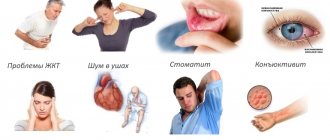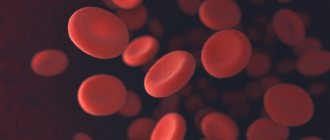Panavir, 0.04 mg/ml, solution for intravenous administration, 5 ml, 2 pcs.
Solution for intravenous administration
IV
jet slowly. The therapeutic dose of the drug is 200 mcg of active substance (contents of 1 amp. or 1 vial).
For the treatment of herpes virus infections and tick-borne encephalitis, it is used twice with an interval of 48 or 24 hours. If necessary, the course of treatment can be repeated after 1 month.
For the treatment of cytomegalovirus and human papillomavirus infections, it is used three times during the first week with an interval of 48 hours and twice during the second week with an interval of 72 hours.
For the treatment of gastric and duodenal ulcers in the acute phase and symptomatic ulcers of the gastroduodenal zone, 5 IV injections are used every other day for 10 days.
For the treatment of rheumatoid arthritis in combination with herpesvirus infection in immunocompromised patients, 5 IV injections are used with an interval of 24–48 hours; if necessary, the course can be repeated after 2 months.
For the treatment of ARVI and influenza, 2 IV injections are used with an interval of 18–24 hours.
For the treatment of patients with chronic bacterial prostatitis, 5 intravenous injections are used with an interval of 48 hours.
Use in pediatrics
: Panavir® is prescribed to children over 12 years of age at a dose of 100 mcg IV once a day. For the treatment of herpes virus infections and tick-borne encephalitis, it is used twice with an interval of 48 or 24 hours. If necessary, the course of treatment can be repeated after 1 month. For the treatment of cytomegalovirus and human papillomavirus infections, it is used three times during the first week with an interval of 48 hours and twice during the second week with an interval of 72 hours.
Gel for external and local use
Externally and locally
. The gel is applied in a thin layer to the affected areas of the skin and/or mucous membranes 5 times a day. Duration of treatment is 4–5 days. The course of treatment can be extended up to 10 days.
Rectal suppositories
Rectally.
For the treatment of herpes virus infections and tick-borne encephalitis, use 1 supp. twice with an interval of 48 or 24 hours. If necessary, the course of treatment can be repeated after 1 month.
For the treatment of cytomegalovirus and human papillomavirus infections, 1 supp. three times during the first week with an interval of 48 hours and twice during the second week with an interval of 72 hours.
For the treatment of ARVI and influenza, 1 supp. at 24 hour intervals for 5 days.
Vaginal suppositories
Intravaginally.
Insert into the vagina in the evening, as deep as possible, in a supine position with slightly bent legs, 1 vag daily for 5 days. supp. A repeated course of treatment is possible after consulting a doctor.
Panavir® is an original Russian antiviral drug of plant origin with a wide spectrum of antiviral action. Panavir® increases the body's resistance to various infections and promotes the production of interferon, a protective protein produced by the body's cells in response to infection by viruses.
The substance Panavir is a biologically active polysaccharide obtained from the plant Solanum tuberosum (Nightshade) and belongs to the class of high molecular weight hexose glycosides of complex structure. The Panavir molecule contains: glucose, galactose, rhamnose, mannose, xylose and uronic acids.
The composition of Panavir has original pharmacological properties, is well tolerated by patients, and is successfully used where conventional antiviral drugs do not work, are contraindicated or work unsatisfactorily.
Indications for use of Panavir® :
- Treatment of herpes (including recurrent genital herpes, herpes zoster (herpes zoster) and herpetic lesions of the eyes (ophthalmoherpes). Primary and recurrent herpetic lesions of the skin and mucous membranes of various localizations.
- Treatment of HPV and treatment of papilloma (anogenital warts) in their complex therapy.
- Treatment of ARVI as part of complex therapy.
- Treatment of influenza as part of complex therapy.
- Secondary immunodeficiency states due to infectious diseases.
- Treatment of cytomegalovirus. Chronic cytomegalovirus infection in pregnant women in the second and third trimester, as well as in patients with recurrent miscarriage. Can be used in women with chronic viral infection and interferon deficiency in preparation for pregnancy.
- Treatment of gastric and duodenal ulcers as part of complex therapy.
- Treatment of tick-borne encephalitis as part of complex therapy.
- Treatment of rheumatoid arthritis as part of complex therapy.
- Treatment of prostatitis as part of complex therapy.
- For the prevention and relief of symptoms of infectious and inflammatory diseases caused by viruses, bacteria and fungi.
Panavir® is available in several dosage forms:
- Solution for intravenous administration instructions
- Rectal suppositories instructions
- Vaginal suppositories instructions
- Gel for external and local use, 3 g instructions
- Gel for external and local use, 30 g instructions
- Spray Panavir® Intim annotation
- Spray Panavir® Inlight annotation
To correctly select complex treatment with Panavir, we recommend that you contact specialized medical institutions.
Comprehensive rehabilitation and a unique method of treating patients for herpes and papilloma using the drug Panavir is carried out at the Likhvinskie Vody sanatorium, located in the Krainka resort, 2.5 hours along the Kyiv highway.
The Where to Buy section contains the addresses and telephone numbers of pharmacies that regularly supply the drug Panavir®, as well as information about the additional service for targeted delivery of drugs and orders via the Internet.
Contraindications
- Severe diseases of the kidneys and spleen (for vaginal suppositories);
- Age up to 12 years (for solution for intravenous administration) or 18 years (for other dosage forms of the drug);
- Pregnancy (for vaginal and rectal suppositories; for solution for intravenous administration - the prescription of Panavir is possible only after assessing the balance of benefits with risks for the health of the woman and the fetus, with the exception of the use of the drug in the II-III trimester as part of complex treatment for exacerbation of chronic cytomegalovirus infection ; for gel - prescription is possible only after assessing the balance of benefits and risks for the health of the woman and the fetus);
- Lactation period;
- Hypersensitivity to the components of the drug.
Side effects
Vaginal suppositories
Allergic reactions may develop.
If any undesirable disturbances occur, you should interrupt therapy and consult a specialist.
Gel
At the site of application of Panavir, short-term redness and itching of the skin and/or mucous membranes may be observed.
Rectal suppositories, solution for intravenous administration
Panavir is generally well tolerated by patients.
Possible disorders may be associated with hypersensitivity to the components of Panavir.
Reviews about Panavir
According to reviews, Panavir in the form of rectal suppositories is well tolerated if the treatment regimen prescribed by the doctor is followed, and there are practically no side effects. Doctors and patients claim that intravenous administration of the drug gives excellent results after the first use for various diseases. However, Panavir solution must be used strictly in accordance with the recommendations of a specialist.
Patients also respond mostly positively to Panavir gel. According to them, in the treatment of herpes and papillomas, the drug acts much faster than its analogues, eliminating all symptoms of herpetic activity in just a few days. However, this dosage form can only cope with warts as part of complex therapy.
Vaginal suppositories can quickly get rid of discomfort in the intimate area and cure many infectious diseases.
Release form and composition
Panavir is available in the following dosage forms:
- Rectal suppositories: from white with a yellowish tint to white, cylindrical or cone-shaped, odorless; The presence of yellowish-gray inclusions is allowed (in blister packs of 5 pcs., 1 or 2 packs in a cardboard box);
- Vaginal suppositories: translucent, grayish-white, cylindrical or cone-shaped (in blister packs of 5 pcs., 1 pack in a cardboard box);
- Gel for external and local use: white, homogeneous, has a slight specific odor (in aluminum tubes with an internal varnish coating of 3, 5, 10 or 30 g, 1 tube in a cardboard box);
- Solution for intravenous (IV) administration: slightly opalescent or transparent, with a light brown tint or colorless, odorless (in neutral glass ampoules or bottles, sealed with rubber stoppers with rolled aluminum caps, 5 ml, 2 or 5 ampoules or vials in blister packs, 1 or 2 packs in a cardboard box (for ampoules - complete with or without an ampoule knife or scarifier)).
The active substance is a purified extract of Solanum tuberosum shoots - a hexose glycoside consisting of uronic acids, rhamnose, glucose, galactose, arabinose, xylose, mannose (Panavir).
Composition of 1 rectal suppository:
- Active substance: Panavir – 0.2 mg;
- Additional components: paraffin - 90 mg, solid or confectionery fat - 1019.8 mg, T-2 emulsifier - 90 mg.
Composition of 1 vaginal suppository:
- Active substance: Panavir – 0.2 mg;
- Additional components: macrogol 1500 (polyethylene oxide 1500) – 1259.9 mg, macrogol 400 (polyethylene oxide 400) – 139.9 mg.
Composition of 10 mg gel for external and local use:
- Active substance: Panavir – 0.0002 mg;
- Additional components: 95% ethanol - 0.1 mg, sodium hydroxide -0.04 mg, lanthanum nitrate hexahydrate - 0.22 mg, macrogol 4000 - 1.5 mg, macrogol 400 - 3.8 mg, glycerol - 3 mg, water – up to 10 mg.
Composition of 1 bottle or ampoule of solution for intravenous administration:
- Active substance: Panavir – 0.2 mg;
- Additional components: sodium chloride – 45 mg, water for injection – up to 5 ml.
special instructions
Vaginal suppositories
In order to prevent the development of urogenital reinfection, simultaneous treatment of sexual partners is recommended. If there is no effect or insufficient effectiveness of Panavir, the diagnosis should be confirmed.
Gel
It is recommended to start treatment in the early stages of the disease, when the first symptoms appear, such as itching, redness, tingling, and a feeling of tension. In this case, the occurrence of the vesicular stage of the disease can be prevented.
According to the instructions, Panavir is not used in ophthalmology.
When applying the gel to the face area, you should avoid getting it into the eyes.
Solution for intravenous administration
For cytomegalovirus and herpesvirus infections, the use of Panavir during preparation for pregnancy helps reduce the frequency of reproductive losses.
The introduction of a cloudy solution is prohibited.
Impact on the ability to drive vehicles and complex mechanisms
There is no reliable data indicating the negative impact of Panavir on the ability to drive a car and perform potentially dangerous types of work that require increased concentration and immediate psychomotor reactions.
Pharmacological properties
Pharmacodynamics
Panavir is a purified extract of shoots of the Solanum tuberosum plant. Its main active component is a hexose glycoside, which includes uronic acids, glucose, galactose, xylose, mannose, and arabinose. This determines its antiviral and immunomodulatory properties.
The drug enhances the body's nonspecific resistance to pathogens of various infections and promotes the production of alpha and gamma interferons by blood leukocytes. At recommended doses, the drug is usually well tolerated. Studies prove the absence of embryotoxic, teratogenic, allergenic and carcinogenic effects. Preclinical studies on laboratory animals did not reveal any negative effects on reproductive function and prenatal development of the fetus. Studies of a model of experimental exudative edema confirmed the presence of anti-inflammatory properties in the drug.
Pharmacokinetics
When the solution is administered intravenously, polysaccharides are detected in the blood approximately 5 minutes after administration of the drug. Subsequently, they are captured by the cells of the reticuloendothelial system of the liver and spleen. These compounds are eliminated primarily through the lungs and kidneys quite quickly. Polysaccharides are detected in urine and air exhaled by a person within 20-30 minutes after administration.



